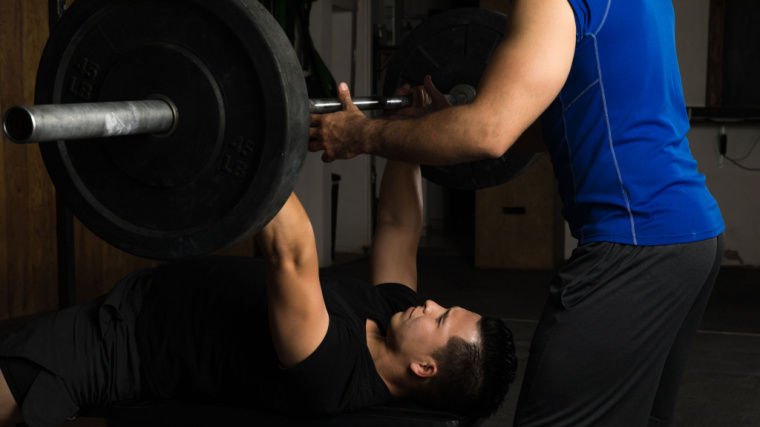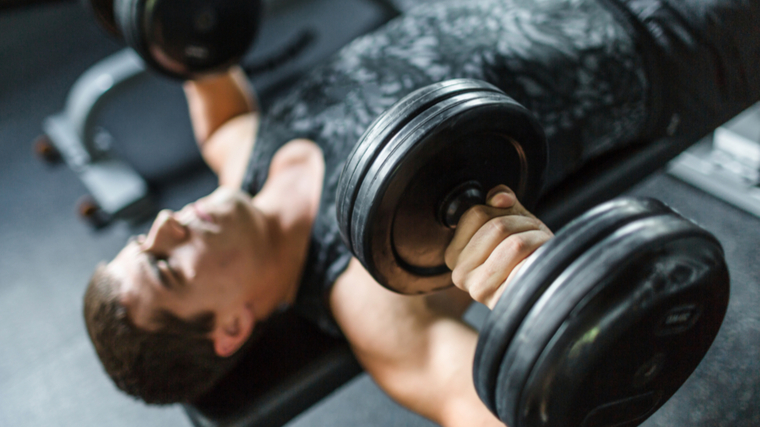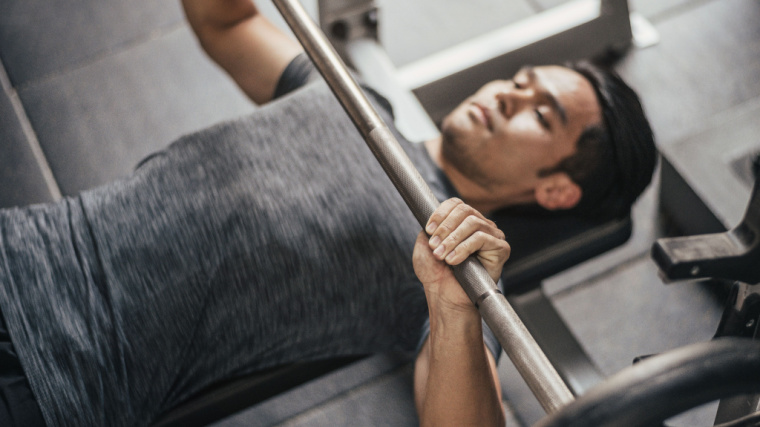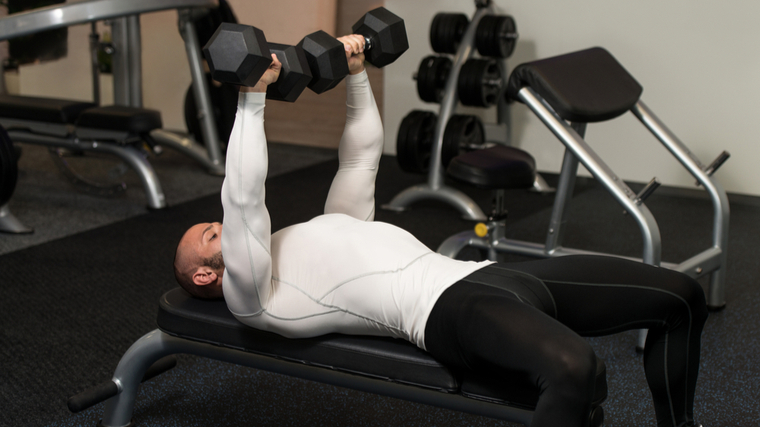Ahh, the mythical bench press. It holds a special place in many lifters’ hearts. The draw of a muscular chest, rounded shoulders, and bulging triceps is what makes many fall in love with benching, either with a barbell or a pair of dumbbells.
Whether you’re an athlete or just want to look good, bench pressing is the go-to pressing exercise to slap on upper body size and strength.

The barbell bench press is an integral member of the powerlifting big three, along with the back squat and deadlift. The classic bench is even associated with its own day the week. Who hasn’t wanted to do the barbell bench press on a Monday only to find a dozen other gym members with the same idea?
Fortunately, it’s half-brother — the dumbbell bench press — is a similar movement, but it’s even more forgiving on the joints and you need to work harder overall to stabilize the weights. Here we’ll dive deep into both exercises so you can choose when to perform each according to your goals. Let’s get ready to bench press, one way or the other.
Dumbbell Bench Press and Barbell Bench Press
- Exercise Differences
- Exercise Similarities
- Technique Differences
- How to Dumbbell Bench Press
- How to Barbell Bench Press
- Programming the Right Press for Your Body and Goal
Dumbbell and Barbell Bench Press Differences
The key differences to the naked eye seem apparent — it’s the equipment, either one barbell or two dumbbells are used. But the press setup and other slight differences should also be noticed between these two fantastic pressing variations.
Muscle Recruitment
Both exercises recruit the pectorals (chest), deltoids (shoulder), and triceps to varying degrees depending on the variation used. The barbell locks your joints into a specific range of motion every time. Because it’s one connected unit, the barbell’s stability allows you to press more weight than dumbbells, which require each arm to work independently.

The pressing path with the dumbbells often varies slightly with each rep and requires more upper-body stabilizers because the range of motion (ROM) isn’t fixed — the weights tend to sway in all directions more than a barbell. This means your rotator cuff and shoulder stabilizers are turned on more to protect your shoulder joint.
Setup
Unless you have specialized equipment, there is no way to unrack and re-rack dumbbells like with the barbell bench press. Getting the dumbbells in position for the press requires effort and sound technique to avoid injury, and the same when you have finished your press. Getting the dumbbells into the starting position can become even more challenging as your working weights get heavier.
With a barbell, it’s a relatively simple matter of unracking the bar from the bench supports and replacing it at the end of the set. The process is identical regardless of the weight on the bar.
Grip
A barbell allows you to press using either a standard overhand grip, a false (thumbless) grip, or even an underhand grip. Each of these have their own benefits — the underhand grip recruits more of your shoulders and biceps for added stability, while the false grip can help to reduce shoulder joint strain. (1) However, the barbell doesn’t offer any freedom of movement at your wrists during the movement. Once you grip the bar, you’re locked into that position until the set ends.
Dumbbells allow much more variety of wrist movement, which can reduce strain on your elbows and shoulder joints. One key difference is that dumbbells allow you to press with a neutral (palms facing) grip. Not only does that put your shoulders and arms in the strongest leverage position, but it stresses the shoulder joint less because it is neither internally nor externally rotated.
Dumbbell and Barbell Bench Press Similarities
Both flat bench press variations are horizontal presses, where you lie on your back, press the weight up, and lower it down. In that vein, there are several similarities despite the equipment and setup differences. Here’s how you know the exercises are different branches of the same tree.
Training The Same Muscles
Because they’re both horizontal pressing movements, with your body in the same position relative to the weight, both the dumbbell press and and barbell bench press engage the chest as the primary working body part.
Both exercises are completed with assistance from your triceps and shoulders (particularly the anterior, or front, head of the muscle), while your upper back, core, and even your legs contribute to total-body stability.
Upper Body Pressing Power and Strength
The barbell bench press is the pressing variation where you’ll be able to use more overall weight, which lends itself to building serious upper pressing power and strength. It’s not uncommon for an experienced lifter to barbell bench press 300 or more pounds.

While the dumbbell bench press doesn’t allow for as much total load — using a pair of 100-pound dumbbells, or 200 total pounds, would be an achievement for gym veterans— the exercise still creates a tremendous strength-building stimulus. Both exercises involve horizontal adduction (bringing your arms together toward your centerline), and both can build muscle, strength, and power in the chest and triceps.
Key Technique Differences
The dumbbell bench press and the barbell bench press have specific technique differences influencing the results delivered. Here’s a closer look at exactly what makes them different.
Pressing Path
With the dumbbell bench press, you’re coordinating the weights as you press each dumbbell individually. This can address muscular imbalances between your left and right sides, while the barbell requires you to push as a single unit with both hands. This changes the pressing path and range of motion in a few ways.
The dumbbells can move in a distinct arc and allow for more arm adduction — you can bring your arms close to each other in the top position, which cannot be done with a barbell.

The barbell’s range of motion is more fixed because your hand stays in place and the barbell stops at chest-level. The dumbbells aren’t blocked by your chest in the bottom position, which can allow for a little more range of motion and a more extensive stretch on the chest and shoulders.
Upper Body Position
It is common with the barbell bench press to see a significant lower back arch and a puffed-out chest to shorten the range of motion. This acts as a type of counterbalance and can especially happen when using heavier weight.
This is difficult to do with the dumbbell bench press, and this position isn’t as necessary because there is no need to meet your chest with the dumbbells. While you do still need to use your lower body to brace during the dumbbell bench press, your torso stays mostly flat on the bench.
Dumbbells are also relatively more difficult to stabilize throughout the exercise, meaning each rep will be very slightly different from the next because your shoulder stabilizers will be working harder than with the barbell movement.
Grip Options
The barbell locks your hands into two basic types of grip: overhand or underhand (which can both be done with dumbbells). The barbell bench press allows you to vary the width of your grip to change the emphasis on the muscles trained. Pressing with your hands closer will prioritize your triceps, while a wider grip will emphasize your chest and shoulders.
The most significant difference between the traditional barbell and dumbbells is the ability to press with a neutral grip which stresses the wrists, elbows, and shoulder joints less, making it a better choice if discomfort or poor joint mobility is an issue.
How to Dumbbell Bench Press
Sit on a flat bench with a dumbbell on each knee. Lie back and raise your knees to drive the dumbbells back towards your shoulders while pressing the dumbbells up into a locked out position above your chest.
Slowly lower the weights, keeping your elbows angled out at roughly 45-degrees. In the bottom position, when your elbows are nearly level with your torso or when you’ve reached a comfortable stretch, push the dumbbells back up.
Form Tip: Because of the potentially increased range of motion when using dumbbells, some lifters have a tendency to think “more is better.” But when you drop your elbows below-level with your torso, your shoulders become more externally rotated which puts them in a more vulnerable position. Keep your elbows roughly even with your torso in the bottom position to reduce the risk of joint strain.
Benefits
- Lifting each dumbbell individually can help strengthen developmental imbalances between arms.
- The dumbbell bench press lets you train with a high intensity using a relatively lower weight, which can improve upper body size and strength without wear and tear from heavy loading.
- It gives your wrist, elbow, and shoulder joints a break from the barbell because of the ability to use a neutral grip.
Dumbbell Bench Press Variations
The dumbbell offers better freedom of movement, allowing you to train the dumbbell bench press from varying angles and positions for better overall muscle development.
Single-Arm Dumbbell Floor Press
This single-arm floor press will train your core and shoulder stabilizers more due to the offset load that gets neglected during bilateral (two-arm) pressing.
It’s also a shoulder-saver because it eliminates the lower range of motion, which is where the shoulder is externally rotated and problems like shoulder impingement can happen.
Dumbbell Squeeze Press
When it comes to building strength and muscle, tension is king. (2) The squeeze press cranks up muscle tension to the next level. You perform this like a regular dumbbell bench press, but you press the hex dumbbells together (similar to the top of a dumbbell flye) throughout the entire repetition.
This extra tension provided by the constant contraction means you’ll need to use a lighter weight than a standard dumbbell bench press, but this variation will fire up your chest like few other exercises.
How To Barbell Bench Press
Lie down on a flat bench, slightly arch your lower back, and plant your feet on the floor. Pull your shoulder blades together and grip the bar with at a comfortable and powerful width, outside of your shoulders. For added control, squeeze your hands hard to flex your arms and gripping muscles.
Unrack the barbell and think about pulling it toward your body to touch near your sternum or the base of your chest. Press the bar up, keeping your upper back tight and your shoulder blades pulled together.
Form Tip: Many lifters think the barbell bench press is just an “upper body” exercise, but this couldn’t be further from the truth. Creating tension with your lower body — pushing your feet back and down which flexes your calves, hamstrings, and glutes — is a counterbalance that builds total-body stability and helps you press more weight safely.
Benefits
- The barbell bench press recruits a number of upper body muscles including the chest, shoulders, triceps, biceps, and lats, which helps to build more upper body size and strength.
- Compared to the dumbbell bench press, you can potentially load the bench press up with a very heavy weight.
- It has direct carryover for powerlifters because it’s one of the three lifts judged in a competition.
Barbell Bench Press Variations
There are several effective barbell bench press variations, but the two below will particularly help build lockout strength in your triceps, which has a huge carryover to your barbell bench press performance.
Close Grip Bench Press
A close-grip bench press is the same in every respect as the standard bench press, but you set your hands roughly shoulder-width apart. This changes your leverage and shifts the load more to your triceps and less to your chest.
Because the arm position focuses more on the triceps, it takes some stress off the shoulder joints but places slightly more stress on the elbow joints. It’s a delicate balancing act, and it is best to vary your grip width to avoid overuse injuries.
Barbell Floor Press
Similar to the dumbbell floor press but a little harder to initially set up, the barbell floor press lets use more weight than the dumbbell variation. It is a shoulder-saver and focuses more on the triceps than the chest because of the reduced range of motion.
One of the most significant advantages of the barbell floor press is that it takes the lower body out of it to focus entirely on strict upper body pressing power. If you don’t have access to an adjustable squat rack with a low setting to place the bar, then finding a spotter to help get the bar into position is necessary.
When to Program the Dumbbell or Barbell Bench Press
Many lifters perform the barbell bench press and its variations because that is what they have always done. But don’t discount the dumbbell bench press, as both can be used to improve your upper body strength and size.
Competitive Powerlifting
The barbell bench press is one of the powerlifting “big three,” along with the barbell squat and deadlift, so it should always take priority in every competitive powerlifter’s program.
However, pressing with a barbell all the time may give rise to overuse injuries due to exaggerating strength imbalances and cumulative wear and tear on your joints from being locked into the same range of motion. Occasionally using the dumbbell bench press and its variations as “accessory exercises” will give your joints a break and reduce imbalances between arms.
General Strength
Either bench press variation can be effective for non-competitive lifters interested in building strength. With its increased stability and fixed ROM, the barbell bench press allows you to lift heavier weights than the dumbbell bench press. And dumbbells in most gyms only go so high and become awkward to get into position; the barbell bench press should form most of your strength work.
Use the dumbbell bench press to strengthen imbalances between sides and as a break for the barbell when your joints begin to bark at you. But both bench variations will deliver strength gains; it’s a matter of personal preference.
Building Muscle
When building slabs of upper body muscle is your goal, both bench press variations can work hand in hand. Bilateral lifts like the barbell bench press allow you to lift heavier total weight, which may benefit a muscle-building program because heavy loads are one way to achieve muscle-building tension.
The dumbbells, being lighter individually, are better for higher rep training which can also deliver an increased muscle-building stimulus.
Lifters With Long Arms
Lifters with relatively long arms will have a longer range of motion when it comes to pressing compared those with shorter arms. Generally speaking, those with shorter arms can lift more weight due to shorter levers creating a favorable pressing position.
Lifters with long arms can use either variation, but should consider how their joints feel on any given day when choosing which to perform. To avoid aggravating joints, opt for the dumbbell bench press.
Let’s Get Ready To Press
There is no one-size-fits-all to determine which bench press variation you should use. Some lifters feel no discomfort and can efficiently press with only a barbell to their heart’s content. For other lifters, the barbells make their joints angry and not worth the trouble. The choice between the two sometimes comes down to comfort, personal preference, and goal. But if pain and discomfort are not an issue, both should be used in a comprehensive plan to improve your upper body size, strength, and flexing time.
Research
- Lehman G. J. (2005). The influence of grip width and forearm pronation/supination on upper-body myoelectric activity during the flat bench press. Journal of strength and conditioning research, 19(3), 587–591. https://ift.tt/jIlnGX1
- Burd, Nicholas & Andrews, Richard & West, Daniel & Little, Jonathan & Cochran, Andrew & Hector, Amy & Cashaback, Joshua & Gibala, Martin & Potvin, James & Baker, Steven & Phillips, Stuart. (2011). Muscle time under tension during resistance exercise stimulates differential muscle protein sub-fractional synthetic responses in men. The Journal of physiology. 590. 351-62. 10.1113/jphysiol.2011.221200.
Featured Image: Monkey Business Images / Shutterstock
The post Dumbbell vs. Barbell Bench Press: Choose the Right Upper-Body Builder appeared first on Breaking Muscle.
from Breaking Muscle https://ift.tt/inLGSFw https://ift.tt/G83YKHM







No comments
Post a Comment
Please do not enter any spam link in comment box.